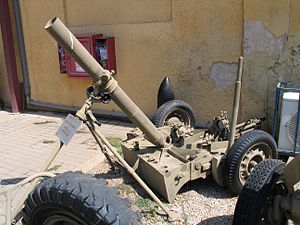- Ordnance ML 4.2 inch Mortar
-
Ordnance SB 4.2 inch Mortar 
Ordnance ML 4.2 inch Mortar on mobile baseplateType Mortar Place of origin United Kingdom Service history In service 1942- Used by  United Kingdom
United KingdomWars Second World War Production history Number built about 3,800[1] Specifications Weight * Barrel weight: Mk 2 92 lbs - Tripod & mounting weight: 112 lbs
- Base plate weight: No 2 baseplate 120 lbs, with auxiliary baseplate fitted 318 lbs, mobile baseplate 602 lbs
Barrel length Mk 1 64 inches, Mk 2 68 inches Calibre 4.2 inch (106.7 mm)[2][3] Elevation 45° - 80° Traverse 10° Rate of fire 20 rounds for 1 minute, 15 for 3 minutes, 10 for sustained fire Maximum range 4,100 yards (3,750 m) The Ordnance ML 4.2 inch Mortar was a heavy mortar used by the British and other armies.
Contents
History
The SB 4.2 inch mortar British entered service in 1942 to equip chemical warfare companies of the Royal Engineers. The Mark 3 became the standard model. The mortar was a Smooth Bore (SB) design of the Stokes pattern. It was designed by the Armaments Research and Development Establishment and produced in Ordnance Factories.[4]
It was first used at El Alamein and all the HE ammunition in the theatre was expended. Soon after the chemical warfare companies were disbanded and one company of each divisional machine gun battalion was re-equipped with the mortar. Divisions also held a pool for issue to other units as required, usually troops in the divisional anti-tank regiment. However, these mortars did not reach Burma although they were used by Australian forces in the South West Pacific.
After World War II the mortars equipped light batteries of the Royal Artillery. 170 Light Battery used them at the Battle of Imjin River in Korea. They were used during the 1950s, including by airborne artillery, deployed to Kuwait in 1961 and manned by soldiers from air defence batteries during Confrontation in Borneo in 1965.
Description
The mortar had an integrated trailer and baseplate called the Mk 1 Mobile Baseplate. The wheels on suspension arms were unlocked and raised for firing, Mk1/1 had detachable wheels. The barrel with tripod attached was stowed on top for towing. A standard baseplate was available and there was an auxiliary baseplate that fitted around it to increase its area for use in softer ground. The normal detachment was 6 men, but the trailer mounting could be brought into action by 2 men.[5] In World War II it had its own ammunition trailer.
HE (9.1 kg) and smoke (10.2 kg) ammunition was used. Smoke include WP and Base Ejection, and in World War II other types for practice. Two charges were available. In World War II both streamlined and cylindrical bombs were available
Users
After World War II users included: UK, Australia, Ethiopia, Laos, Malaysia, Nepal, Turkey.
Notes
References
- Pugh, Stevenson (1962). Fighting Vehicles and Weapons of the Modern British Army (First ed.). London: Macdonald.
- Bidwell, Shelford (1977). Artillery of the World (First ed.). London: Brassey’s. ISBN 0904609049.
- Maintenance Manual for ML 2-inch, ML 3-inch and SB 4.2-inch Mortars
- Bishop, Chris. The Encyclopedia of Weapons of WWII. http://books.google.co.uk/books?id=MuGsf0psjvcC&lpg=PA194&ots=K4XAweMGaH&dq=Britrish%204.2%20inch%20mortar&pg=PA194#v=onepage&q=&f=false.
- "British Mortars of the Second World War". WWIIEquipment. http://www.wwiiequipment.com/index.php?option=com_content&view=article&id=91:british-mortars-of-the-second-world-war&catid=47:british&Itemid=59.
British & Commonwealth small arms of World War II and KoreaSide-arms Rifles & submachine guns SMLE No.1 Mk III* & Lee-Enfield No.4 Mk.I · Pattern 1914 Enfield · Lee-Enfield No.5 Mk.I "Jungle Carbine" · De Lisle Commando Carbine · Sten · Lanchester · Austen · Owen Gun · Welgun · M1921/M1928/M1 ThompsonMachine-guns &
other larger weaponsBren Gun · Charlton Automatic Rifle · Lewis Gun · Vickers MG · PIAT · Rifle, Anti-Tank, .55 in, Boys · SBML 2inch Mortar · ML 3-inch Mortar · No.2 "Lifebuoy" FlamethrowerGrenades British grenades of WWI and WW2 · Mills BombSmall arms cartridges Weapons of the British Empire and the Commonwealth of Nations 1722–1965Handguns Rifles and carbines Brown Bess Musket · Ferguson rifle · Nock gun · Baker Infantry Rifle · Brunswick rifle · Enfield 1853 Rifled Musket · Snider-Enfield · Martini-Henry · Martini-Enfield · Lee-Metford · Lee-Enfield · Ross rifle · Lee-Enfield No.5 Mk.I "Jungle Carbine" · Howell Automatic Rifle · Huot Automatic Rifle · Reider Automatic Rifle · De Lisle Commando Carbine · L1A1 SLRSubmachine guns Rapid-fire weapons Bira gun · Nordenfelt gun · Gatling gun · Gardner gun · Maxim gun · QF 2 pdr "Pom-Pom" · Vickers Gun · Lewis Gun · Vickers-Berthier · Vickers K machine gun · Charlton Automatic Rifle · Besa · Besal · Bren gunAnti-tank weapons Field guns
and other weapons25 pdr Field Gun · Congreve rocket · SBML 2-inch Mortar · Ordnance ML 3 inch Mortar · No.2 "Lifebuoy" Flamethrower · Stokes Mortar · OTO Melara Mod 56Categories:- Mortars of the United Kingdom
- World War II British infantry mortars
- Military equipment of the British Empire
- 107 mm artillery
- Korean War mortars
Wikimedia Foundation. 2010.
